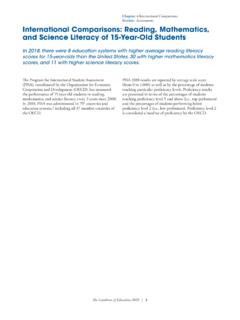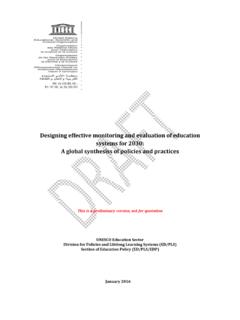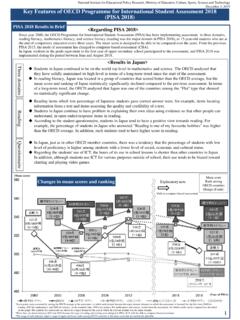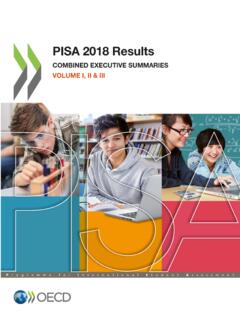Transcription of Research evidence on reading for pleasure
1 Research evidence on reading for pleasure Education standards Research team May 2012 2 Contents Introduction 3 Key findings 3 The evidence on reading for pleasure 3 What works in promoting reading for pleasure ? 6 Definitions 8 The evidence on reading for pleasure 9 Benefits of reading for pleasure 9 Trends in reading for pleasure 13 Changes in numbers of children reading for pleasure over time 15 Children s perceptions of readers 15 Types of reading 16 Reasons children read 17 Gender differences in reading for pleasure 18 What works in promoting reading for pleasure ? 21 Strategies for improving independent reading 21 Online reading habits 24 The role of librarians in reading for pleasure 26 Library use and reading for pleasure 26 References 28 3 Introduction The first section of this briefing note highlights Research evidence on reading for pleasure from domestic and international literature; exploring evidence on the trends and benefits of independent reading amongst both primary and secondary- aged children, as well as why children read.
2 The second section of this briefing covers the evidence on what works in terms of promoting reading for pleasure . Key findings The evidence on reading for pleasure Benefits of reading for pleasure : There is a growing body of evidence which illustrates the importance of reading for pleasure for both educational purposes as well as personal development (cited in Clark and Rumbold, 2006). evidence suggests that there is a positive relationship between reading frequency, reading enjoyment and attainment (Clark 2011; Clark and Douglas 2011). reading enjoyment has been reported as more important for children s educational success than their family s socio-economic status (OECD, 2002). There is a positive link between positive attitudes towards reading and scoring well on reading assessments (Twist et al, 2007). Regularly reading stories or novels outside of school is associated with higher scores in reading assessments (PIRLS, 2006; PISA, 2009).
3 International evidence supports these findings; US Research reports that independent reading is the best predictor of reading achievement (Anderson, Wilson and Fielding, 1988). evidence suggests that reading for pleasure is an activity that has emotional and social consequences (Clark and Rumbold, 2006). Other benefits to reading for pleasure include: text comprehension and grammar, positive reading attitudes, pleasure in reading in later life, increased general knowledge (Clark and Rumbold, 2006). 4 Trends in reading for pleasure In general, the available evidence suggests that the majority of children say that they do enjoy reading (Clark and Rumbold, 2006). In 2010, 22% of children said they enjoyed reading very much; 27% said they enjoyed it quite a lot; 39% said they enjoyed it quite a bit, and 12% reported that they did not enjoy reading at all (Clark 2011).
4 Comparing against international evidence , children in England report less frequent reading for pleasure outside of school than children in many other countries (Twist et al, 2007). There is consistent evidence that age affects attitudes to reading and reading behaviour; that children enjoy reading less as they get older (Topping, 2010; Clark and Osborne, 2008; Clark and Douglas 2011). However, some evidence suggests that while the frequency with which young people read declines with age, the length for which they read when they read increases with age (Clark 2011). A number of studies have shown that boys enjoy reading less than girls; and that children from lower socio-economic backgrounds read less for enjoyment than children from more privileged social classes (Clark and Rumbold, 2006; Clark and Douglas 2011). Some evidence has shown children from Asian background have more positive attitudes to reading and read more frequently than children from White, mixed or Black backgrounds (Clark and Douglas 2011).
5 Changes in numbers of children reading for pleasure over time Research is accumulating that suggests that a growing number of children do not read for pleasure (Clark and Rumbold, 2006). Between 2000 and 2009, on average across OECD countries the percentage of children who report reading for enjoyment daily dropped by five percentage points (OECD, 2010). This is supported by evidence from PIRLS 2006 (Twist et al, 2007) which found a decline in attitudes towards reading amongst children. 5 Children s perceptions of readers A greater percentage of primary than secondary aged children view themselves as a reader (Clark and Osborne, 2008). A greater proportion of primary aged readers and non-readers (than secondary aged) believed that their friends saw readers as happy and people with a lot of friends (Clark and Osborne, 2008). Types of reading Text messages, magazines, websites and emails have been found to be the most common reading choices for young people.
6 Fiction is read outside the class by two-fifths of young people (Clark and Douglas 2011). Some evidence suggests that more young people from White backgrounds read magazines, text messages and messages on social networking sites and more young people form Black backgrounds read poems, eBooks and newspapers (Clark 2011). Twist et al (2007) report a slight increase in the proportion of children who claim to be reading comics/comic books and newspapers at least once or twice a week in England. There is mixed evidence on whether primary or secondary children read a greater variety of materials (Clark and Osborne, 2008; Clark and Foster, 2005). Young people who receive1 free school meals (FSM) are less likely to read fiction outside of the classroom (Clark 2011). Most young people read between one and three books in a month (Clark and Poulton 2011b). Reasons children read reading for pleasure is not always cited as the key reason for children reading .
7 Other reasons include skills-based reasons or reasons to do with learning and understanding (Nestle Family Monitor, 2003; Clark and Foster, 2005). Another popular reason given is emotional relating to the way reading makes children feel (Dungworth et al, 2004). 1 The surveys reported on pupils who received or did not receive free school meals (FSM) rather than pupils who were FSM eligible or not. 6 Gender differences in reading for pleasure A number of studies have shown that boys enjoy reading less than girls. evidence has found that 58% of girls enjoy reading either very much or quite a lot in comparison to 43% of boys (Clark and Douglas 2011). In all countries, boys are not only less likely than girls to say that they read for enjoyment, they also have different reading habits when they do read for pleasure ; with girls more likely to read fiction or magazines, and boys more likely to read newspapers or comics (OECD, 2010).
8 evidence from the Programme for International Student Assessment (PISA) has shown that boys are on average 39 points behind girls in reading , the equivalent of one years schooling. One study reports that boys are reading nearly as much as girls, but they tend to read easier books (Topping, 2010). What works in promoting reading for pleasure ? Strategies to improve independent reading Having access to resources and having books of their own has an impact on children s attainment. There is a positive relationship between the estimated number of books in the home and attainment (Clark 2011). Children who have books of their own enjoy reading more and read more frequently (Clark and Poulton 2011). An important factor in developing reading for pleasure is choice; choice and interest are highly related (Schraw et al, 1998; Clark and Phythian-Sence, 2008) Literacy-targeted rewards, such as books or book vouchers have been found to be more effective in developing reading motivation than rewards that are unrelated to the activity (Clark and Rumbold, 2006).
9 Parents and the home environment are essential to the early teaching of reading and fostering a love of reading ; children are more likely to continue to be readers in homes where books and reading are valued (Clark and Rumbold, 2006). reading for pleasure is strongly influenced by relationships between teachers and children, and children and families (Cremin et al, 2009). 7 Online reading habits There is little Research that has been conducted specifically looking at online reading habits; the existing evidence has mixed results. Twist et al (2007) report finding a negative association between the amount of time spent reading stories and articles on the internet and reading achievement in most countries in PIRLS data. However, other Research finds that those reading from the internet score well in reading assessments (Scottish analysis of PISA data, 2004), and PISA reports that young people who are extensively engaged in online reading activities are generally found to be more proficient readers (OECD, 2010).
10 Library use and reading for pleasure Research reports a link between library use and reading for pleasure ; young people that use their public library are nearly twice as likely to be reading outside of class every day (Clark and Hawkins, 2011). 8 Definitions As Clark and Rumbold (2006) note, the terms reading for pleasure , reading for enjoyment and their derivates are used interchangeably. reading for pleasure is also frequently referred to, especially in the US, as independent reading (Cullinan, 2000), voluntary reading (Krashen, 2004), leisure reading (Greaney, 1980), recreational reading (Manzo and Manzo, 1995) or ludic reading (Nell, 1988, all cited in Clark and Rumbold, 2006). reading for pleasure has been defined by the National Literacy Trust as reading that we do of our own free will, anticipating the satisfaction that we will get from the act of reading .

















